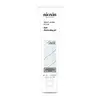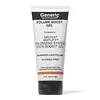What's inside
What's inside
 Benefits
Benefits

 Concerns
Concerns

 Ingredients Side-by-side
Ingredients Side-by-side

Water
Skin ConditioningSorbitol
HumectantGlycerin
HumectantAminomethyl Propanol
BufferingCarbomer
Emulsion StabilisingOctylacrylamide/Acrylates/Butylaminoethyl Methacrylate Copolymer
Phenoxyethanol
PreservativePanthenol
Skin ConditioningAmodimethicone
PEG-40 Hydrogenated Castor Oil
EmulsifyingParfum
MaskingTrideceth-12
EmulsifyingMentha Arvensis Leaf Oil
MaskingMentha Piperita Oil
MaskingBenzyl Salicylate
PerfumingCetrimonium Chloride
AntimicrobialHexyl Cinnamal
PerfumingCitric Acid
BufferingAlpha-Isomethyl Ionone
PerfumingLimonene
PerfumingLinalool
PerfumingCitronellol
PerfumingWater, Sorbitol, Glycerin, Aminomethyl Propanol, Carbomer, Octylacrylamide/Acrylates/Butylaminoethyl Methacrylate Copolymer, Phenoxyethanol, Panthenol, Amodimethicone, PEG-40 Hydrogenated Castor Oil, Parfum, Trideceth-12, Mentha Arvensis Leaf Oil, Mentha Piperita Oil, Benzyl Salicylate, Cetrimonium Chloride, Hexyl Cinnamal, Citric Acid, Alpha-Isomethyl Ionone, Limonene, Linalool, Citronellol
Water
Skin ConditioningAmp-Acrylates/Allyl Methacrylate Copolymer
Pvp
Emulsion StabilisingPEG-14 Dimethicone
Skin ConditioningAcrylates/C10-30 Alkyl Acrylate Crosspolymer
Emulsion StabilisingPropylene Glycol
HumectantAminomethyl Propanol
BufferingPEG-40 Hydrogenated Castor Oil
EmulsifyingPhenoxyethanol
PreservativePolysorbate 80
EmulsifyingPEG-40
HumectantMethylparaben
PreservativeParfum
MaskingEthylparaben
PreservativeAlpha-Isomethyl Ionone
PerfumingEthylhexyl Methoxycinnamate
UV AbsorberHexyl Cinnamal
PerfumingButylphenyl Methylpropional
PerfumingLinalool
PerfumingBenzyl Salicylate
PerfumingLimonene
PerfumingBenzyl Benzoate
AntimicrobialCitronellol
PerfumingOleth-10
EmulsifyingGeraniol
PerfumingDisodium Cocoamphodipropionate
CleansingOctylacrylamide/Acrylates/Butylaminoethyl Methacrylate Copolymer
Lecithin
EmollientPhosphoric Acid
BufferingPolyquaternium-10
Disodium EDTA
Water, Amp-Acrylates/Allyl Methacrylate Copolymer, Pvp, PEG-14 Dimethicone, Acrylates/C10-30 Alkyl Acrylate Crosspolymer, Propylene Glycol, Aminomethyl Propanol, PEG-40 Hydrogenated Castor Oil, Phenoxyethanol, Polysorbate 80, PEG-40, Methylparaben, Parfum, Ethylparaben, Alpha-Isomethyl Ionone, Ethylhexyl Methoxycinnamate, Hexyl Cinnamal, Butylphenyl Methylpropional, Linalool, Benzyl Salicylate, Limonene, Benzyl Benzoate, Citronellol, Oleth-10, Geraniol, Disodium Cocoamphodipropionate, Octylacrylamide/Acrylates/Butylaminoethyl Methacrylate Copolymer, Lecithin, Phosphoric Acid, Polyquaternium-10, Disodium EDTA
Ingredients Explained
These ingredients are found in both products.
Ingredients higher up in an ingredient list are typically present in a larger amount.
Alpha-Isomethyl Ionone is a fragrance. It can be synthetically created or naturally occurring.
The scent of Alpha-Isomethyl Ionone is described as "flowery" but can also be "woody".
Naturally occurring Alpha-Isomethyl Ionone may be found in Saccharomyces cerevisiae, or the yeast used to make wine and bread.
The term 'fragrance' is not regulated in many countries. In many cases, it is up to the brand to define this term. For instance, many brands choose to label themselves as "fragrance-free" because they are not using synthetic fragrances. However, their products may still contain ingredients such as essential oils that are considered a fragrance.
Learn more about Alpha-Isomethyl IononeAminomethyl Propanol is used to adjust the pH of products. It is also used as a base to create other organic compounds. Having a balanced pH is important for protecting your skin.
Aminomethyl propanol is safe to use in cosmetics up to 1%. It is soluble in water.
Benzyl Salicylate is a solvent and fragrance additive. It is an ester of benzyl alcohol and salicylic acid. This ingredient can be naturally found in some plants and plant extracts.
In fragrances, Benzyl Salicylate may be a solvent or a fragrance component. In synthetic musk scents, it is used as a solvent. For floral fragrances such as lilac and jasmine, it is used as a fragrance component. The natural scent of Benzyl Salicylate is described as "lightly-sweet, slightly balsamic".
While Benzyl Salicylate has been associated with contact dermatitis and allergies, emerging studies show it may not be caused by this ingredient alone.
However, this ingredient is often used with fragrances and other components that may cause allergies. It is still listed as a known allergen in the EU. We recommend speaking with a professional if you have concerns.
Another study from 2021 shows Benzyl Salicylate may have anti-inflammatory properties.
Learn more about Benzyl SalicylateCitronellol is used to add fragrance/parfum to a product. It is often derived from plants such as roses. In fact, it can be found in many essential oils including geranium, lavender, neroli, and more. The scent of Citronellol is often described as "fresh, grassy, and citrus-like".
Since the Citronellol molecule is already unstable, Citronellol becomes irritating on the skin when exposed to air.
Citronellol is a modified terpene. Terpenes are unsaturated hydrocarbons found in plants. They make up the primary part of essential oils.
Citronellol is not able to be absorbed into deeper layers of the skin. It has low permeability,
Citronellol is also a natural insect repellent.
Learn more about CitronellolHexyl Cinnamal is a fragrance ingredient with a similar scent to jasmine. It can be naturally found in chamomile essential oil.
This ingredient is a known EU allergen and may sensitize the skin. The EU requires this ingredient to be listed separately on an ingredients list.
Hexyl Cinnamal is not water soluble but is soluble in oils.
Learn more about Hexyl CinnamalLimonene is a fragrance that adds scent and taste to a formulation.
It's found in the peel oil of citrus fruits and other plants such as lavender and eucalyptus. The scent of limonene is generally described as "sweet citrus".
Limonene acts as an antioxidant, meaning it helps neutralize free radicals.
When exposed to air, oxidized limonene may sensitize the skin. Because of this, limonene is often avoided by people with sensitive skin.
The term 'fragrance' is not regulated in many countries. In many cases, it is up to the brand to define this term. For instance, many brands choose to label themselves as "fragrance-free" because they are not using synthetic fragrances. However, their products may still contain ingredients such as essential oils that are considered a fragrance.
Learn more about LimoneneLinalool is a fragrance and helps add scent to products. It's derived from common plants such as cinnamon, mint, citrus, and lavender.
Like Limonene, this ingredient oxidizes when exposed to air. Oxidized linalool can cause allergies and skin sensitivity.
This ingredient has a scent that is floral, spicy tropical, and citrus-like.
Learn more about LinaloolWe don't have a description for Octylacrylamide/Acrylates/Butylaminoethyl Methacrylate Copolymer yet.
Parfum is a catch-all term for an ingredient or more that is used to give a scent to products.
Also called "fragrance", this ingredient can be a blend of hundreds of chemicals or plant oils. This means every product with "fragrance" or "parfum" in the ingredients list is a different mixture.
For instance, Habanolide is a proprietary trade name for a specific aroma chemical. When used as a fragrance ingredient in cosmetics, most aroma chemicals fall under the broad labeling category of “FRAGRANCE” or “PARFUM” according to EU and US regulations.
The term 'parfum' or 'fragrance' is not regulated in many countries. In many cases, it is up to the brand to define this term.
For instance, many brands choose to label themselves as "fragrance-free" because they are not using synthetic fragrances. However, their products may still contain ingredients such as essential oils that are considered a fragrance by INCI standards.
One example is Calendula flower extract. Calendula is an essential oil that still imparts a scent or 'fragrance'.
Depending on the blend, the ingredients in the mixture can cause allergies and sensitivities on the skin. Some ingredients that are known EU allergens include linalool and citronellol.
Parfum can also be used to mask or cover an unpleasant scent.
The bottom line is: not all fragrances/parfum/ingredients are created equally. If you are worried about fragrances, we recommend taking a closer look at an ingredient. And of course, we always recommend speaking with a professional.
Learn more about ParfumPeg-40 Hydrogenated Castor Oil is derived from castor oil and polyethylene glycol (PEG). It is used as a emollient and emulsifier.
As an emulsifier, it helps prevent ingredients from separating. It also helps make the other ingredients more soluble; it is often used to solubilize fragrances. This increases spreadability and elongates shelf life in a product.
Emollients help soothe and soften the skin. They do this by creating a protective film on your skin. This barrier helps trap moisture and keeps your skin hydrated. Emollients may be effective at treating dry or itchy skin.
This ingredient may or may not be vegan, depending on the source.
Peg-40 Hydrogenated Castor Oil may not be fungal-acne safe. We recommend speaking with a professional if you have any questions or concerns.
Learn more about PEG-40 Hydrogenated Castor OilPhenoxyethanol is a preservative that has germicide, antimicrobial, and aromatic properties. Studies show that phenoxyethanol can prevent microbial growth. By itself, it has a scent that is similar to that of a rose.
It's often used in formulations along with Caprylyl Glycol to preserve the shelf life of products.
Water. It's the most common cosmetic ingredient of all. You'll usually see it at the top of ingredient lists, meaning that it makes up the largest part of the product.
So why is it so popular? Water most often acts as a solvent - this means that it helps dissolve other ingredients into the formulation.
You'll also recognize water as that liquid we all need to stay alive. If you see this, drink a glass of water. Stay hydrated!
Learn more about Water